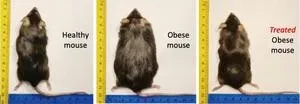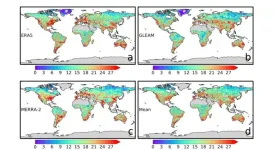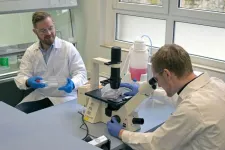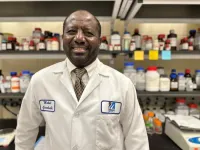(Press-News.org) A multidisciplinary team lead by University of Texas at Arlington mathematics Assistant Professor Souvik Roy is on a mission to improve medical imaging using a new technique called quantitative photoacoustic tomography (QPAT).A multidisciplinary team lead by University of Texas at Arlington mathematics Assistant Professor Souvik Roy is on a mission to improve medical imaging using a new technique called quantitative photoacoustic tomography (QPAT).
QPAT is an imaging modality that combines ultrasound, which is an imaging technique that uses sound waves to image features inside the body, and optical tomography. It uses acoustic wave intensity data measured on the surface of the body through a scanner composed of acoustic wave detectors. This allows for the development of images of various optical properties of tissues, like absorption and diffusion, which can provide crucial information regarding the location and stage of a cancerous tissue.
“QPAT is robust because it uses information from two types of imaging techniques and has the potential to provide high-quality images. It can tell us so much more about what’s going on under the skin,” Roy said. “By providing better images, doctors will be able to make more accurate diagnoses in shorter time frames. This will lessen anxiety for patients as well as decrease costs for the health care industry by reducing the need for repeated scans.”
One of the major challenges in developing QPAT is the lack of adequate acoustic wave measurements on the surface of the body, which can significantly degrade the quality of the images and result in inaccurate diagnosis of cancerous tumors. To circumvent this issue, principal investigator Roy and his multidisciplinary team—comprising statistician co-principal investigator Suvra Pal and radiologists—have received a $190,000 grant from the National Science Foundation to significantly develop and improve the QPAT imaging technique.
The team will use a novel combination of game theory, statistical sensitivity analysis and gradient-free optimal control methods to help complete the missing acoustic wave measurements and stabilize and recalibrate computational algorithms for providing high-contrast and high-resolution images.
“We hope to facilitate a safe start to research on imaging human subjects using QPAT,” Roy said. “Our ultimate goal is helping patients get better and develop more accurate images in a shorter time frame. These enhanced scans should help doctors and patients make better health care treatment decisions. Down the line, we know this will improve outcomes, reduce patient anxiety and be highly cost-effective.”
END
New imaging technique could provide clearer images for oncologists
Roy’s technique combines ultrasound, optical tomography to help doctors make diagnoses
2023-08-29
ELSE PRESS RELEASES FROM THIS DATE:
Neptune's disappearing clouds linked to the solar cycle
2023-08-29
Astronomers have uncovered a link between Neptune's shifting cloud abundance and the 11-year solar cycle, in which the waxing and waning of the Sun's entangled magnetic fields drives solar activity.
This discovery is based on three decades of Neptune observations captured by NASA's Hubble Space Telescope and the W. M. Keck Observatory in Hawaii, as well as data from the Lick Observatory in California.
The link between Neptune and solar activity is surprising to planetary scientists because Neptune is our solar system's farthest major planet and receives sunlight with about 0.1% ...
Liver-targeting drug reverses obesity, lowers cholesterol in mice
2023-08-29
A University of Massachusetts Amherst biomedical engineer has used a nanogel-based carrier designed in his lab to deliver a drug exclusively to the liver of obese mice, effectively reversing their diet-induced disease.
“The treated mice completely lost their gained weight, and we did not see any untoward side effects,” says S. Thai Thayumanavan, distinguished professor of chemistry and biomedical engineering. “Considering 100 million Americans have obesity and related cardiometabolic disorders, we became pretty excited about this work.”
Efforts ...
MIND Institute director calls for new approach to equity in autism, fragile X research
2023-08-29
UC Davis MIND Institute Director Leonard Abbeduto is calling for a major shift in the way research into autism and other neurodevelopmental disabilities is conducted. He co-authored a paper titled “Toward Equity in Research on Intellectual and Developmental Disabilities” that was the basis for a special issue of the American Journal on Intellectual and Developmental Disabilities. The issue was published today.
Abbeduto, a distinguished professor in the Department of Psychiatry and Behavioral Sciences, argues that researchers ...
Rapid shifts from drought to downpour occurring more often
2023-08-29
New research shows that wild swings from severe drought to heavy rains are becoming more common with climate change in many parts of the world and that feedback loops from the land itself are likely contributing to the trend.
The research looked at four decades of meteorological and hydrological data on a global level and found seven regional hotspots around the world where the trend was getting worse: eastern North America, Europe, East Asia, Southeast Asia, southern Australia, southern Africa, and southern South America.
“We are especially concerned with the sudden shift from drought to flood,” said coauthor Zong-Liang Yang, a professor at The University of Texas at Austin Jackson ...
Hemp helps to heal
2023-08-29
A few days ago, the federal government took the controversial decision to make the acquisition and possession of small amounts of cannabis exempt from punishment. Provided the German parliament approves the draft bill, the “Cannabis Act” will come into force next year. While some consider this move to be long overdue, others continue to warn strongly against the health risks of cannabis use.
The Jena researchers and their colleagues are now taking a different look at cannabis – at the traditional medicinal ...
Department of Energy announces $24 million for research on quantum networks
2023-08-29
WASHINGTON, D.C. - Today, the U.S. Department of Energy (DOE) announced $24 million in funding for three collaborative projects in quantum network research.
Scientific research infrastructure linked with quantum networks is needed to realize distributed quantum computers. These quantum computers could simulate complex scientific processes inaccessible to computational platforms of today, integrate quantum sensors that promise measurements of unprecedented precision, and address previously inaccessible scientific questions of importance.
“Advances in quantum networking are enabling effective interconnections ...
A new fly model developed to find treatments for UBA5 deficiency, a rare epileptic brain disorder
2023-08-29
Developmental and epileptic encephalopathy (DEE) refers to a group of neurodevelopmental conditions characterized by developmental delay, cognitive impairment, and seizures in children. In 2016, the first case linking variants in both the copies of UBA5 gene to DEE44 was reported. Since then, twelve distinct missense variants in the UBA5 gene have been identified in 25 patients. A recent study by Dr. Hugo J. Bellen and his team at the Jan and Dan Duncan Neurological Research Institute (Duncan NRI) at Texas Children’s Hospital and Baylor College of ...
Statewide project to provide care and support to people living with dementia and their care partners
2023-08-29
INDIANAPOLIS—An Indiana University School of Medicine statewide project in collaboration with Indiana University Health was recently funded to support people living with dementia as well as their family care partners find more support and resources, thanks to a new $686,000 grant from the National Institute on Aging IMPACT Collaboratory.
The Aging Brain Care Virtual program will be the first study to test dementia collaborative care in Indiana University Health primary care. The project will utilize the ...
Magnitude of placebo response identified in drug for treatment of hot flashes
2023-08-29
WACO, Texas (Aug. 29, 2023) – Hot flashes are one of the most concerning and most reported symptoms among menopausal women and breast cancer survivors. Currently, paroxetine is a FDA-approved non-hormonal drug used for the treatment of hot flashes. In an article published this month in the journal Frontiers in Psychiatry, researchers at Baylor University tested the efficacy of paroxetine by conducting a systematic review and meta-analysis of six clinical trials, finding that the benefits of paroxetine in the treatment of hot flashes to be comparable to that of the placebo response.
The study included information ...
Presenting non-traditional symptoms, women suffer worse heart disease outcomes than men
2023-08-29
Media Contacts:
Emily Gowdey-Backus, director of media relations
Nancy Cicco, assistant director of media relations
More than a dozen medical studies from around the globe show women suffer worse outcomes when diagnosed with and treated for cardiac issues – the No. 1 killer in the world according to the Centers for Disease Control.
The discrepancy, as summarized by UMass Lowell biomedical and nutritional sciences Associate Professor Mahdi O. Garelnabi of the Zuckerberg College of Health Sciences and colleagues from the University of Maryland School of Medicine, Lebanese American ...
LAST 30 PRESS RELEASES:
Numbers in our sights affect how we perceive space
SIMJ announces global collaborative book project in commemoration of its 75th anniversary
Air pollution exposure and birth weight
Obstructive sleep apnea risk and mental health conditions among older adults
How talking slows eye movements behind the wheel
The Ceramic Society of Japan’s Oxoate Ceramics Research Association launches new international book project
Heart-brain connection: international study reveals the role of the vagus nerve in keeping the heart young
Researchers identify Rb1 as a predictive biomarker for a new therapeutic strategy in some breast cancers
Survey reveals ethical gaps slowing AI adoption in pediatric surgery
Stimulant ADHD medications work differently than thought
AI overestimates how smart people are, according to HSE economists
HSE researchers create genome-wide map of quadruplexes
Scientists boost cell "powerhouses" to burn more calories
Automatic label checking: The missing step in making reliable medical AI
Low daily alcohol intake linked to 50% heightened mouth cancer risk in India
American Meteorological Society announces Rick Spinrad as 2026 President-Elect
Biomass-based carbon capture spotlighted in newly released global climate webinar recording
Illuminating invisible nano pollutants: advanced bioimaging tracks the full journey of emerging nanoscale contaminants in living systems
How does age affect recovery from spinal cord injury?
Novel AI tool offers prognosis for patients with head and neck cancer
Fathers’ microplastic exposure tied to their children’s metabolic problems
Research validates laboratory model for studying high-grade serous ovarian cancer
SIR 2026 delivers transformative breakthroughs in minimally invasive medicine to improve patient care
Stem Cell Reports most downloaded papers of 2025 highlight the breadth and impact of stem cell research
Oxford-led study estimates NHS spends around 3% of its primary and secondary care budget on the health impacts of heat and cold in England
A researcher’s long quest leads to a smart composite breakthrough
Urban wild bees act as “microbial sensors” of city health.
New study finds where you live affects recovery after a hip fracture
Forecasting the impact of fully automated vehicle adoption on US road traffic injuries
Alcohol-related hospitalizations from 2016 to 2022
[Press-News.org] New imaging technique could provide clearer images for oncologistsRoy’s technique combines ultrasound, optical tomography to help doctors make diagnoses









